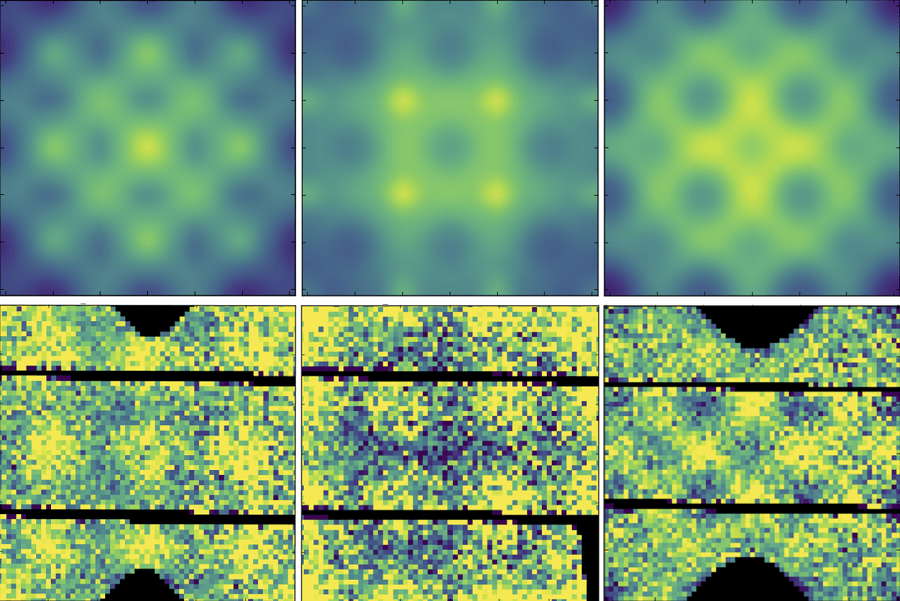Jan 12 2018
A research team led by the U.S. Department of Energy’s (DOE) Argonne National Laboratory has tapped the characteristics of neutrons to investigate electrons in a metal, thereby gaining new knowledge related to the behavior of correlated electron systems — materials having propitious characteristics such as superconductivity or magnetism.
 A comparison of the theoretical calculations (top row) and inelastic neutron scattering data from ARCS at the Spallation Neutron Source (bottom row) shows the excellent agreement between the two. The three figures represent different slices through the four-dimensional scattering volumes produced by the electronic excitations. (Image credit: Argonne National Laboratory)
A comparison of the theoretical calculations (top row) and inelastic neutron scattering data from ARCS at the Spallation Neutron Source (bottom row) shows the excellent agreement between the two. The three figures represent different slices through the four-dimensional scattering volumes produced by the electronic excitations. (Image credit: Argonne National Laboratory)
The study, which will be published in the journal Science, demonstrates the extent to which researchers can estimate the characteristics and performance of materials, enabling them to investigate their ability to be used in innovative ways.
“Our mission from the Department of Energy is to discover and then understand novel materials that could form the basis for completely new applications,” stated Ray Osborn, lead author of the study, who is a senior scientist in Argonne’s Neutron and X-ray Scattering Group.
Osborn and his team investigated a strongly correlated electron system (CePd3) by adopting neutron scattering to overcome the drawbacks of other methods and to show the way in which the electrical characteristics of the compound get altered at low and high temperatures. Osborn anticipates that the outcomes will encourage similar studies in the future.
Being able to predict with confidence the behavior of electrons as temperatures change should encourage a much more ambitious coupling of experimental results and models than has been previously attempted.
In many metals, we consider the mobile electrons responsible for electrical conduction as moving independently of each other, only weakly affected by electron-electron repulsion. However, there is an important class of materials in which electron-electron interactions are so strong they cannot be ignored.
Ray Osborn, Lead Author
Researchers have analyzed these strongly correlated electron systems for over 50 years, and the most significant theoretical hypothesis is that at higher temperatures, the electron interactions result in random fluctuations that hinder their mobility.
“They become ‘bad’ metals,” stated Osborn. Yet, at lower temperatures, the electronic activations start looking similar to those of usual metals, however with much decreased electron velocities.
The presence of this interchange from disordered random fluctuations at higher temperatures to ordered electronic states at lower temperature was postulated in the year 1985 by Jon Lawrence, one of the co-authors of the study, who is a professor at the University of California, Irvine. Despite obtaining certain evidence for this from photoemission experiments, Stephan Rosenkranz, Argonne co-author, observed that it is highly challenging to compare these evaluations with pragmatic theoretical computations as there are numerous ambiguities in simulating the experimental intensities.
The researchers, mainly based at Argonne and other DOE laboratories, demonstrated that neutrons investigate the electrons in a distinct manner that overcomes the drawbacks of photoemission spectroscopy and other methods.
This study was made possible by developments in neutron spectroscopy at DOE’s Spallation Neutron Source (SNS) at Oak Ridge National Laboratory, a DOE Office of Science User Facility, and the United Kingdom’s ISIS Pulsed Neutron Source, which enable comprehensive evaluations over a broad array of momentum transfers and energies. Both have significant roles in this research.
Neutrons are absolutely essential for this research. Neutron scattering is the only technique that is sensitive to the whole spectrum of electronic fluctuations in four dimensions of momentum and energy, and the only technique that can be reliably compared to realistic theoretical calculations on an absolute intensity scale.
Ray Osborn, Lead Author
Through this research, these four-dimensional evaluations have at present been directly compared with computations made by adopting innovative computational methods specifically created for strongly correlated electron systems. The method, called Dynamical Mean Field Theory, describes a way of computing electronic characteristics, including strong electron-electron interactions.
The contributions of Eugene Goremychkin, a former Argonne researcher who headed the data analysis, and Hyowon Park, an Argonne theorist who carried out the computations, were acknowledged by Osborn. The accordance between experiments and theory was “truly remarkable,” stated Osborn.
In the future, the scientists are confident about bridging the gap between the outcomes of experiments in condensed matter physics and theoretical models.
“How do you get to a stage where the models are reliable?” stated Osborn. “This paper shows that we can now theoretically model even extremely complex systems. These techniques could accelerate our discovery of new materials.”
Park and John-Paul Castellan of the Materials Science Division are the other Argonne authors of the paper titled “Coherent Band Excitations in CePd3: A Comparison of Neutron Scattering and ab initio Theory.” Scientists from the Joint Institute for Nuclear Research in Russia, the University of Illinois at Chicago, Karlsruhe Institute of Technology in Germany, Oak Ridge National Laboratory, Los Alamos National Laboratory, and the University of California at Irvine also contributed to this study.
DOE’s Materials Sciences and Engineering Division of the Office of Basic Energy Sciences funded the study at Argonne and Los Alamos. The Scientific User Facilities Division of the Office of Basic Energy Sciences supported the study at Oak Ridge’s SNS. Neutron experiments were conducted at the SNS and the ISIS Pulsed Neutron Source, Rutherford Appleton Laboratory in the United Kingdom. Also contributing to this study is Blues, a high-performance computing cluster run by the Laboratory Computing Resource Center at Argonne.